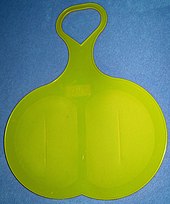Toboggan
This article needs additional citations for verification. (August 2015) |
A toboggan is a simple sled traditionally used by children. It is also a traditional form of transport used by the Innu and Cree of northern Canada.

In modern times, it is used on snow to carry one or more people (often children) down a hill or other slope for recreation. Designs vary from simple, traditional models to modern engineered composites. A toboggan differs from most sleds or sleighs in that it has no runners or skis (or only low ones) on the underside. The bottom of a toboggan rides directly on the snow. Some parks include designated toboggan hills where ordinary sleds are not allowed and which may include toboggan runs similar to bobsleigh courses.[1]
Toboggans can vary depending on the climate and geographical region. Such examples are Tangalooma (Australia) where toboggans are made from Masonite boards and used for travelling down steep sand dunes at speeds up to 40 km/h (25 mph).
Etymology
[edit]The term toboggan likely comes from an Algonquin language, though the exact one is not sure.[2] It likely comes from the Mikasuki word tepaqan, meaning sled, or the Abenaki word dabôgan, meaning sled.
Design and use
[edit]

Toboggan was originally an Algonquian term for a type of man-hauled cargo sledge made from bark, hardwood or whalebone, and deer or buffalo hide.[3] Sledges of this type have been in use on the Great Plains and the Great Lakes since 3000 BCE.[4] During the tribes' yearly migration to their winter campsites, these sledges were used to transport bulky personal possessions and small children before the introduction of the wheel. A smaller variant of the toboggan, used for recreational purposes, was known as a Tom Pung.[5] As Europeans settled traditional Algonquian lands, the term was absorbed as an English loanword and applied to the low-profile wooden sledges made by the colonists.[6]
The Mountaineer [Innu] method is the only one adapted for the interior parts of the country: their sleds are made of two thin boards of birch; each about six inches broad, a quarter of an inch thick, and six feet long: these are fastened parallel to each other by slight battens, sewed on with thongs of deer-skin; and the foremost end is curved up to rise over the inequalities of the snow. Each individual who is able to walk, is furnished with one of these; but those for the children are proportionately less. On them they stow all their goods, and also their infants; which they bundle up very warm in deer-skins. The two ends of a leather thong are tied to the corners of the sled; the bight or double part of which is placed against the breast, and in that manner it is drawn along. The men go first, relieving each other in the lead by turns; the women follow next, and the children, according to their strength, bring up the rear; and, as they all walk in rackets (snowshoes), the third or fourth person finds an excellent path to walk on, let the snow be ever so light.[7]

The precursor to the modern American toboggan was the small, utilitarian sledge used by woodcutters in Russia, Scandinavia, and especially Germany, to transport logs when the snow made roads inaccessible. Sledge races were a popular winter sport in mountainous countries during the pre-Industrial Revolution era, and early German colonists in America improved upon the design of the traditional toboggan by giving it a lower, more streamlined profile to increase its speed.
The traditional American toboggan is made of bound, parallel wood slats, all bent up and backwards at the front to form a recumbent 'J' shape. A thin rope is run across the edge of end of the curved front to provide rudimentary steering. These usually lack the iron runners of the older woodcutter's sledges. The frontmost rider places their feet in the curved front space and sits on the flat bed; any others sit behind them and grasp the waist of the person before them.

Toboggans come in a variety of shapes. Modern recreational toboggans are typically manufactured from wood or plastic or aluminum. A small plastic sled on which a rider sits and raises their legs while sledding may be known as a bum slider. Larger, more rugged models are made for commercial or rescue use.
See also
[edit]References
[edit]- ^ Sled, Sledge, Sleigh, and Toboggan grammarist.com differentiation of sledding types
- ^ "Origin".
- ^ Word Detective: toboggan
- ^ Indian terms of the Americas, 224
- ^ Handbook of American Indians, 769
- ^ Indian contributions to the world, page 39
- ^ Townsend 1911:357–358.
External links
[edit]- . New International Encyclopedia. 1905.
